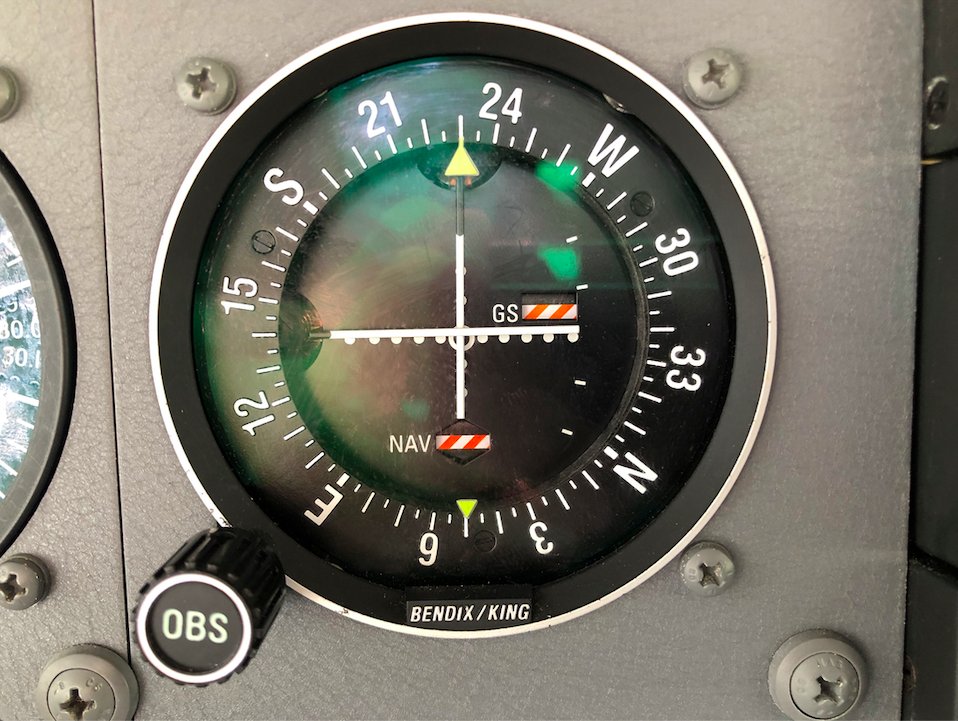
1. I'm going to geek out now and give you a tour of my Cessna 172 cockpit, which I've been learning to fly (in real life). For the pilots among you, feel free to tune out, because this is pretty basic. But I get a lot of questions from non-pilots about what they are looking at. 

2. In the upper center of the panel is the attitude indicator, which (when it's on - the engine is off here) uses a gyroscope to tell the relationship between the plane and the horizon. This is extremely important when visibility is low and your senses can fatally deceive you. 

3. To its left is the airspeed indicator, in nautical miles per hour. The green bar shows normal operating speeds with flaps up. The white bar shows min/max operating speeds with flaps down. The red line is the never exceed speed - your airplane could break up from the stress. 

4. To its right is the altimeter, showing your altitude above sea level (the airport is at 200 feet). It works based on air pressure, so you have to adjust it with the knob below to reflect prevailing air pressure due to weather - which can even change during flight. 

5. In the center of the lower level is the direction indicator, showing which magnetic direction you are heading (N, S, E, W). This also relies on a gyroscope, which makes it more stable, but it has to be reset periodically by referring to the actual magnetic compass. 

6. On the dashboard is a magnetic compass. It can act funky when you are changing direction or speed, so the direction indicator is better. But you need to periodically set the direction indicator to this, or else it will be off. 

7. Lower left is the turn indicator, which uses a gyroscope to tell you if the airplane is skidding or sliding off its turn radius, or deviating away from straight flight, which can be corrected by using the rudder. 

8. Lower right is the vertical speed indicator, which uses air pressure to tell you whether you are rising or falling in altitude. It can help you manage your level flight, climb, or descent, but there's a slight lag you need to be aware of. 

9. To the right of the main instruments are 2-3 navigational instruments. You can set them to designated radio frequencies to direct you to or from a fixed beacon. They can also be used in approaching the runway in low visibility. 

10. To the left are the engine gauges. They tell you whether the fuel and oil are sufficient and working properly. The vacuum pump works the gyroscopic instruments I've mentioned, and the amps tells if you if you are draining or charging the battery. 

11. At the lower left are the electrical and light switches. The numbered buttons are circuit breakers. The red switch turns on the instrument panel, the white switch turns on the radios. The key turns on the engine's ignition system and (initially) the starter to get it going. 

12. To the lower right, the black or silver knob is the throttle, which allows fuel and air to enter the engine. The red knob controls the amount of fuel you want to mix with the air, which can vary by altitude. The selector below chooses which fuel tank fuel will come from. 

13. To the far right, in the same photo, are the flaps, which you can lower which landing (and also taking off). Lowering flaps creates more drag, slowing the aircraft down, but also gives the wings additional lift at any given speed.
14. The "wheel" to the left, below the throttle and fuel mixture knobs, is the trim wheel. This allows you to set a little flap on the tail up or down, relieving the pressure you have to apply to the yoke to point the nose of the aircraft up or down.
15. Someone asked, so I'll answer: these are all analog or "steam" gauges. In other aircraft, these gauges can be replaced with a computer screen (or "glass cockpit") that shows all the same information. There are typically some back-up analog gauges though.
16. Someone also asked: what happens if the power goes out? To get the engine running, there is an electrical starter (activated by the key). But once it is running, the engine generates electrical power via an alternator and two magnetos.
17. The alternator generates the power for the instruments and radio. If it breaks, you will ultimately drain the battery and those instruments will stop working. You also won't be able to raise or lower the flaps.
18. The magnetos are a separate electrical system that fire the spark plugs, to keep the engine going. So even if the main electrical system, and your instruments, fail, the engine should keep working. There are two magnetos, both working at the same time, to back each other up.
19. Instruments can fail in other ways as well. The altimeter, airspeed indicator, and vertical speed indicator all rely on pressure sensors on the outside of the aircraft.
20. The atitude indicador, heading indicator, and turn coordinator all rely on the vacuum pump for the gyroscopes to work. That's why you have a "vac" gauge on the far left, next to the "amps" gauge.
21. For a couple lessons, recently, my direction indictor was broken and would spin and keep spinning like a roulette wheel. We had to use the magnetic compass on the dashboard, with all its flaws, to guide us until it could be replaced.
22. Anyway, hope this was helpful for some people who have asked me questions, and didn't bore others to tears.
23. When I first started, I will admit that there were some instruments I paid attention to, and others my eyes glazed over at and I just hoped were ok. It's been very interesting, though, learning what each of them does and that there's a reason each of them is there.
24. It's also important to understand how each instrument works and what it actually tells you. Because if you don't, they can really mislead you. An altimeter that isn't set to the right pressure is wrong. And even then, high or low temperatures can make it inaccurate.
25. In fact, the altimeter in my photo is set wrong. The airport is really 180 feet above sea level, not 200. Not a big deal in good visibility, but I reset it just before takeoff, and had to reset it again two hours later as the weather changed.
26. When airliners fly above 18,000 feet, they set their altimeters to a standard pressure setting. It's not "accurate", but at that altitude it's much more important that they don't fly into each other because their altimeters are giving them different readings.
27. Oh man, I can't believe I forgot the tachometer, which is at the lower right of the main instrument panel. This tells you how fast the engine is going, and thus how fast the propeller is rotating. On a simple plane, like the 172, it is controlled by the throttle. 

28. For the 172, 2500 rpm is throttle full-in for takeoff or climb. For cruising, you pull the throttle back to 2000-2400, depending on conditions. To descent you pull it back to 1500-1800. For taxiing on the ground, it's typically 1000-1200.
29. If you pull the throttle full out, the engine won't turn off. You have to pull out the fuel mixture to do that. It will just go down to idle, somewhere below 1000 rpm, which is not enough to generate much, if any, forward thrust.
30. The tachometer is hugely important in performing maneuvers correctly, like approach and landing. But in time, you begin to be able to tell rpm from the hum of the engine, and just glance at the tachometer to confirm.
31. Just to conclude, if you go into an airliner cockpit or fighter cockpit, you are going to see these same basic instruments. They may look somewhat different, and how they are utilized may vary a bit, but you will be able to recognize them on anything from a 747 to a F-16.
• • •
Missing some Tweet in this thread? You can try to
force a refresh









